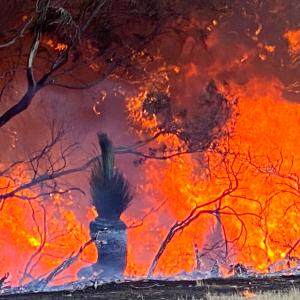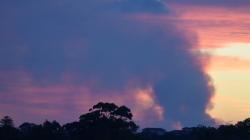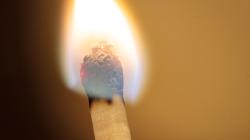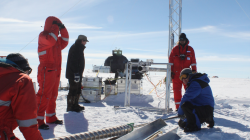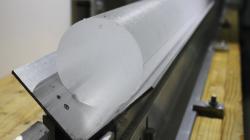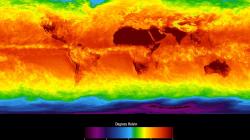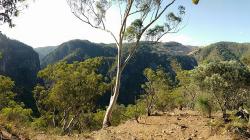'Bushfire and ice' IS ONE OF OUR NEW TEACHING SEQUENCES FOR V9
- On the 'Sequence overview' tab you'll find all the lessons in this sequence and curriculum alignment.
- The 'Our design decisions' tab shows how key scientific ideas develop over the sequence, and shows how the sequence addresses curriculum achievement standards.
- Have you taught this sequence? Use the Feedback button to let us know how it went!
Launch
Lesson 1 • Exploring bushfires
Students examine the prevalence of bushfires, their causes and how people are impacted.
Inquire
Lesson 2 • Fire and combustion reactions
Students conduct a series of activities that explore the reactants and products of a combustion reaction.
Lesson 3 • Carbon dioxide and the carbon cycle
Students model the movement of carbon dioxide produced by combustion through the atmosphere, hydrosphere, biosphere, and geosphere.
Lesson 4 • Measuring biomass
Students measure the biomass in a tree and use a spreadsheet to determine the corresponding amount of carbon dioxide removed from the atmosphere.
Lesson 5 • Ice core evidence
Students analyse 800,000 years of carbon dioxide data and correlate this to changing global temperatures. Students examine how changes in greenhouse gases affect the likelihood of bushfires.
Lesson 5A • Correlating carbon dioxide levels and global temperatures
Students correlate variations in carbon dioxide levels in the atmosphere with global temperature variations.
Lesson 6 • Factors affecting the rate and intensity of bushfires
Students use secondary data to identify the factors that affect the speed a fire travels. They apply their understanding to evaluate a fire with unknown conditions.
Act
Lesson 7 • Design to survive
Students apply their understanding to design a fire action plan for a selected audience and/or present a local plan to reduce the level of carbon dioxide in the atmosphere.
The Australian Academy of Science supports and encourages broad use of its material. Unless indicated below, copyright material available on this website is licensed under a Creative Commons Attribution-NonCommercial-ShareAlike 4.0 International (CC BY-NC-SA 4.0) licence.
Curriculum and syllabus alignment
Achievement standards
By the end of Year 9 students explain how interactions within and between Earth’s spheres affect the carbon cycle. They explain the role of publication and peer review in the development of scientific knowledge and explain the relationship between science, technologies and engineering. They analyse the different ways in which science and society are interconnected.
Students plan and conduct safe, reproducible investigations to test or identify relationships and models. They describe how they have addressed any ethical and intercultural considerations when generating or using primary and secondary data. They select and use equipment to generate and record replicable data with precision. They select and construct appropriate representations to organise, process and summarise data and information. They analyse and connect data and information to identify and explain patterns, trends, relationships and anomalies. They analyse the impact of assumptions and sources of error in methods and evaluate the validity of conclusions and claims. They construct logical arguments based on evidence to support conclusions and evaluate claims. They select and use content, language and text features effectively to achieve their purpose when communicating their ideas, findings and arguments to specific audiences.
Australian Curriculum V9 alignment
Science as a human endeavour
Science understanding
Represent the carbon cycle and examine how key processes including combustion, photosynthesis and respiration rely on interactions between Earth’s spheres (the geosphere, biosphere, hydrosphere and atmosphere)
Science inquiry
Develop investigable questions, reasoned predictions and hypotheses to test relationships and develop explanatory models
Plan and conduct valid, reproducible investigations to answer questions and test hypotheses, including identifying and controlling for possible sources of error and, as appropriate, developing and following risk assessments, considering ethical issues, and addressing key considerations regarding heritage sites and artefacts on Country/Place
Select and use equipment to generate and record data with precision to obtain useful sample sizes and replicable data, using digital tools as appropriate
Select and construct appropriate representations, including tables, graphs, descriptive statistics, models and mathematical relationships, to organise and process data and information
Analyse and connect a variety of data and information to identify and explain patterns, trends, relationships and anomalies
Assess the validity and reproducibility of methods and evaluate the validity of conclusions and claims, including by identifying assumptions, conflicting evidence and areas of uncertainty
Construct arguments based on analysis of a variety of evidence to support conclusions or evaluate claims, and consider any ethical issues and cultural protocols associated with accessing, using or citing secondary data or information
Australian curriculum content links
| Science understanding core concept: The Earth system comprises dynamic and interdependent systems; interactions between these systems cause continuous change over a range of scales. All living things are connected through Earth’s systems and depend on sustainability of the Earth system. |
| Sub-strand | Content descriptor | AC code | Achievement standard | How the sequence addressed this content |
|---|---|---|---|---|
| SHE: Nature and development of science | Explain how scientific knowledge is validated and refined, including the role of publication and peer review. | AC9S9H01 | Explain the role of publication and peer review in the development of scientific knowledge. | Examining the scientific consensus supporting global warming (Lesson 5, 5A). |
| SHE: Nature and development of science | Investigate how advances in technologies enable advances in science, and how science has contributed to developments in technologies and engineering. | AC9S9H02 | Explain the relationship between science, technologies and engineering. | Identifying how technological advances in monitoring greenhouse gas emissions and other environmental factors have contributed to the reinstatement of traditional fire management practices as a strategy to reduce atmospheric pollution (Lesson 4, 5, 5A, 6). |
| SHE: Use and influence of science | Analyse the key factors that contribute to science knowledge and practices being adopted more broadly by society. | AC9S9H03 | Analyse the different ways in which science and society are interconnected. | Examining how First Nations Australians’ fire management practices are informing and being adopted in contemporary fire management (Lesson 6). |
| SHE: Use and influence of science | Examine how the values and needs of society influence the focus of scientific research. | AC9S9H04 | Analyse the different ways in which science and society are interconnected. | Examining the prevalence of bushfires, their causes, and how people are impacted (Lesson 1, 3, 4, 5, 5A, 6). Investigating how the need to minimise greenhouse gas production has led to scientific and technological advances (Lesson 6, 7). |
| SU: Earth and Space Sciences | Represent the carbon cycle and examine how key processes including combustion, photosynthesis, and respiration rely on interactions between Earth’s spheres (the geosphere, biosphere, hydrosphere, and atmosphere). | AC9S9U03 | Explain how interactions within and between Earth’s spheres affect the carbon cycle. | Representing Earth as a system and describing the carbon cycle using simulations and diagrams (Lesson 3). Identifying the impact of combustion reactions on the greenhouse effect and conducting field investigations to evaluate carbon sequestration in an ecosystem (Lesson 2, 3, 4). Investigating how First Nations Australians are reducing greenhouse gas emissions (Lesson 6). |
| SI: Questioning and predicting | Develop investigable questions, reasoned predictions, and hypotheses to test relationships and develop explanatory models. | AC9S9I01 | Plan and conduct safe, reproducible investigations to test or identify relationships and models. | Discussing why a scientific hypothesis must be able to be supported or refuted through evidence (Lesson 1, 2). |
| SI: Planning and conducting | Plan and conduct valid, reproducible investigations to answer questions and test hypotheses, including identifying and controlling for possible sources of error and, as appropriate, developing and following risk assessments, considering ethical issues, and addressing key considerations regarding heritage sites and artefacts on Country/Place. | AC9S9I02 | Describe how they have addressed any ethical and intercultural considerations when generating or using primary and secondary data. | Discussing what is meant by validity and reproducibility in combustion reactions (Lesson 2). Recognising First Nations Australians’ heritage laws and developing an awareness of the intellectual property of their practices (Lesson 6). |
| SI: Planning and conducting | Select and use equipment to generate and record data with precision to obtain useful sample sizes and replicable data, using digital tools as appropriate. | AC9S9I03 | Select and use equipment to generate and record replicable data with precision. | Considering the replicability of data collected by different scientific groups, including the inaccuracies that may be introduced when taking measurements from ice cores (Lesson 5, 5A). |
| SI: Processing, modelling and analysing | Select and construct appropriate representations, including tables, graphs, descriptive statistics, models, and mathematical relationships, to organise and process data and information. | AC9S9I014 | Select and construct appropriate representations to organise, process, and summarise data and information. | Using spreadsheet software to present ice core and biomass data in tabular and graphical form (Lesson 4, 5, 5A). Applying algorithms to measure carbon storage (Lesson 4). |
| SI: Processing, modelling and analysing | Analyse and connect a variety of data and information to identify and explain patterns, trends, relationships, and anomalies. | AC9S9I015 | Analyse and connect data and information to identify and explain patterns, trends, relationships, and anomalies. | Discussing the validity of the data when extrapolating from a graph (Lesson 5, 6). Analysing representations of data from ice cores to identify patterns and trends (Lesson 5). |
| SI: Evaluating | Assess the validity and reproducibility of methods and evaluate the validity of conclusions and claims, including by identifying assumptions, conflicting evidence, and areas of uncertainty. | AC9S9I016 | Analyse the impact of assumptions and sources of error in methods and evaluate the validity of conclusions and claims. | Discussing what is meant by validity and how the validity of information in secondary sources can be evaluated (Lesson 1, 2, 5). Identifying gaps or weaknesses in conclusions drawn from combustion reactions and relating these to the validity and reproducibility of the method (Lesson 2). |
| SI: Evaluating | Construct arguments based on analysis of a variety of evidence to support conclusions or evaluate claims, and consider any ethical issues and cultural protocols associated with accessing, using, or citing secondary data or information. | AC9S9I017 | Construct logical arguments based on evidence to support conclusions and evaluate claims. | Examining secondary ice core data to determine the reliability of the sources and validity and reproducibility of the data (Lesson 5). Identifying multiple forms of evidence that are consistent with the claim of increasing carbon dioxide levels (Lesson 4). Acknowledging and identifying the relationship between First Peoples’ knowledge and contemporary bushfire science provides a shared understanding when working both ways (Lesson 6). |
| SI: Communicating | Write and create texts to communicate ideas, findings, and arguments effectively for identified purposes and audiences, including selection of appropriate content, language, and text features, using digital tools as appropriate. | AC9S9I08 | Select and use content, language, and text features effectively to achieve their purpose when communicating their ideas, findings, and arguments to specific audiences. | Selecting appropriate content and language that is culturally responsive when developing a variety of ways to communicate ideas related to bushfires and carbon dioxide levels in the atmosphere (Lesson 1-7). |
Teaching notes
- Read through the teaching sequence.
- Note any adaptations you would like to make to suit your schools and students’ context.
- Consider how this teaching sequence will assess the curriculum standards. Two options are provided:
- A combination of formative assessment and summative assessment of smaller tasks throughout the teaching sequence, and a Fire Plan as the Act phase, or
- The Act phase involves two summative assessment tasks including a Fire Plan AND a plan to reduce the level of carbon dioxide in the atmosphere, thereby reducing the frequency of bushfires in the future.
- Check that your IT department will allow access to the YouTube videos.
- Complete the ordering of laboratory equipment and rooms (if required).
- Ensure that students can access the excel data spreadsheet required for Lessons 3 and 4.
- Consider the audience you select for students to communicate with.
- It may not be appropriate to select an earlier year level, as developmentally the concepts covered are not appropriate. It also diminishes the repeatability of the sequence, as students in earlier year levels will have already ‘learned’ (albeit in a non-experiential way) about the concepts.
- Presenting to an external audience, for example, local fire service will allow the Year 9 students to not only receive feedback on their science communication skills but also on the accuracy of their information.
- You might also consider asking students to communicate with a parent audience as part of an ‘open-day’ or ‘science-fair’ type experience.
What else might help you prepare to teach this sequence?
- The background science of bushfires: https://www.youtube.com/watch?v=l38UkQmUISs
- Watch https://iview.abc.net.au/show/big-weather-and-how-to-survive-it or https://knowledge.aidr.org.au/resources/big-weather/
- Discussing the key concepts with teachers working in humanities or mathematics to develop a transdisciplinary approach.
- Visits to areas previously affected by bushfire: when considering this, deliberate on the impact on students and the local community.
Lab tech notes—Lesson 2
Lesson 2 requires students to complete a series of activities that explore combustion. There is also an option for teachers to provide a fire demonstration. As required in all states, teachers must prepare their risk assessments of the activities. Some of the risks that need to be considered are listed below.
Flour and fire demonstration
- Flour dust is highly flammable.
- Use controlled amounts of flour dust.
- Consider the direction of the flame and any barriers that could be used to reduce risk.
- Consider if students will mimic the activity.
- Identify the location of fire alarms.
- Remove all flammable materials from around the candle including clothing, books, paper, curtains, flammable decorations, or liquids.
- Limit drafts, vents, or ceiling fans to reduce the risk of items blowing into the flame.
- Ensure an appropriate fire extinguisher or fire blanket is available and accessible at all times.
- Know appropriate first aid in case of a burn.
- Discuss the appropriateness of the risk with the school authorities.
Lime water
- Add 2-3 heaped spatulas of calcium hydroxide into a 500 mL stock bottle and make up with distilled water. Mix well and allow the solids to settle. Filter the mixture to remove the solids.
- Use safety glasses when working with lime water.
- When using a straw to blow into lime water, ensure that you do not suck up the water into the mouth.
- If ingested, immediately dilute with drinking water.
- Wash hands after handling.
- If the lime water makes contact with the skin, wash with running water.
- Remind students not to mimic the teacher in drinking the lime water.
Candles
- Use quality, reliable candles as cheaper candles will burn down quickly and bring the flame into contact with flammable materials.
- Remove all flammable materials from around the candle including clothing, books, paper, curtains, flammable decorations, or liquids.
- Use candles in low-traffic areas and limit the number of people in the area.
- Place the candles on stable, heat-resistant surfaces.
- Only move candles that have been cooled (with solid wax).
- Limit drafts, vents, or ceiling fans to reduce the risk of items blowing into the flame.
- Use stable candleholders made of non-combustible materials.
- Never leave a burning candle unattended.
- Ensure the jars that fit over the candle are large enough to be placed without risking burning fingers.
- Ensure an appropriate fire extinguisher or fire blanket is available and accessible at all times.
- Know appropriate first aid in case of a burn.
The materials required for each lesson are listed on the lesson's page. For the full sequence resource list, download the Preparing to teach this sequence document below.
